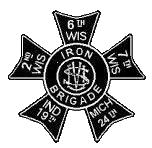“Four Years with the Iron Brigade” – Book Review
“Four Years with the Iron Brigade” The Civil War Journal of William Ray, Company F, Seventh Wisconsin Volunteers.
Edited by Lance Herdegen and Sherry Murphy. Da Capo Press.
Book review by Gary Van Kauwenbergh.
This is the best book of this genre I’ve seen so far. It is neither a diary, nor a collection of letters, but rather a journal of the daily activities of William Ray. William is very literate, and faithfully writes almost every day. There are few gaps in his entries, but William covers the high points of those gaps when he begins writing again. William Ray not only writes often, but he also writes a lot. Some of his daily entries cover more than a page in the book. His entries cover from the inception of the unit, until he’s mustered out at the end of the war.
William is a moralistic teetotaler, who holds himself as above most of his fellow soldiers. That attitude sometimes alienates him. He is promoted to Orderly Sergeant once, but after a short time the troops circulate a petition to have him removed. There’s another spot in the book where he orders his own copy of the Army Regulations through the mail. Very shortly, his “pards” are trying to get him removed from pulling duty as Sergeant of the Guard.
I think William’s character makes the book more interesting, because he frequently points out instances of drinking, gambling, carousing, thievery and other infractions happening in camp. He is opinionated, and not bashful about expressing how he feels on paper.
Here is a small sample of some passages that I found particularly interesting:
*. Short hair, 10/10/61: Haircuts required once a month. Long hair and long beards aren’t allowed.
*. 2nd Wisconsin, 10/31/61: Mention of dark blue pants, white gloves, brass, and ostrich feathers of the 2d Wis. Also mentions the 2d’s nickname “The Bloody Second.”
*. Fiddle, 12/5/61: One of William’s tentmates buys a fiddle. Initially, it gets a mixed welcome.
*. Sham battle, 12/15/61: Five brigades, with cavalry and artillery.
* Inspection/clothing, 12/30/1861: Says gun is “bright as a silver dollar…shoes blacked and brass shining.” Burnishing of the guns is obviously going on. These are the muskets issued before the 7th received their Lorenz muskets. There is a whole list of clothing issued, but the two most interesting items are a cotton coat, and a cap with a cover (Havelock?).
* Lorenz Rifles Ordered, 1/30/1862: The 7th Wis. Ordinance Sergeant makes out the requisition for Lorenz Rifles. “They are a splendid gun. The Second Regt has got them and it leaves us the only Regt. in this brigade with the old musket…”
* Lorenz Rifles, 2/16/62: Describes brass stopple, wormer, screwdriver and wrench. Says new gun is “colored black except the lock guard and rammer which are bright. So we will not have to spend so much time cleaning guns as before.”
* New tents issued, 2/28/62: Sounds like shelter halves
* Football, 4/28/62: “The boys play football and other games…”
* Gibbon, etc, 6/14/62: Gibbon is “verry (sic) much disliked,” Indiana Regt. throws away their clothing. Spends 30 cents on a button brush and box of Tripoli brass polish. Leggings mentioned. Gambling. Sol Meredith goes to Washington to try to get the Indiana Regt out of the brigade. The 7th’s COL goes too. They don’t mind the cleanliness, but they use the term “putting on French airs” referring to the discipline.
* Muskets, 6/20/62: Most of the regiment, at their own expense (10 cents), are staining and varnishing their Lorenz rifle stocks.
* Cleaning, 6/28/62: He talks about soldiers who clean their equipment up immediately after it’s used vs. those that let it go until just before the next inspection, saying those that leave it go use 5 cents worth of emery cloth to scour their guns. Those who clean immediately just use oily cloths.
* Laundry, 7/23/62: Mention that he washed a pair of pants for the first time in his life. Leggings also mentioned.
* Tents, 10/21/63: William sews a two-foot extension onto his tent.
* Ice, 7/3/64: Mentions the unit has plenty of ice taken from a rebel icehouse.
* Indians, 8/30/64: Put in charge of a 10-man squad from Co. G, who are “…mostly Indians. They were the best working squad I have ever been over.”
Towards the end of the war, William’s writing degenerates into the talk of weather and troop movements typical of the published diaries and letter collections, but his writings are rife with details useful to reenactors.
Unfortunately, William Ray seems to be a favorite target for rebel marksmen. He is wounded in the head just as he stepped out of the woods into the field of battle at Brawner’s farm, and is hospitalized during South Mountain and Antietam. He is wounded in the head second time at the very beginning of the battle of Gettysburg. He’s wounded yet a third time in the leg in a subsequent battle. You will not find detailed descriptions of those battles in this book.
I thought I got my monies worth with this book. Hardbound, and nearly 400 pages long, Lance Herdegen copiously footnotes it. Lance’s notes are relevant, well written, and add much to the book. If you only have one book of this type in your library, this is the best one currently on the market.

